Level up your remote work set up

I'm working on remoterig.io, a newsletter to share remote workspaces and tips. My first issue was really easy, I just shared my set up. It's definitely a little over the top and might be more than some people need, especially if you plan on going back to an office after the pandemic.
If you want to follow along, you should subscribe to Remote Rig. Here's the first issue.

In 2014 I joined the team at Wildbit as their first full-time marketer, which was also my first remote role after commuting forty-five minutes one-way to work for six years. The first thing I bought was a USB headset, and slowly over time, I built up my current remote rig. Now I’m part of the largest all-remote team in the world at GitLab.
My goal is to feature a new remote workspace every week and if you’d like to be featured email me at shane@shanerice.com. Each week you’ll get gear and tips to enhance your experience as a remote worker.
Audio
The quality of every video call starts with your mic. I’m on calls all week long, and after years of problems with my audio I made some serious upgrades a few years ago.
It starts with my Rode Procaster microphone. It’s a broadcast-quality dynamic mic with noise reduction to cut down on background noise. It’s mounted on a Rode Swivel Mount Studio Boom Arm, which maximizes space when I’m working while making sure my mic is close on video calls.
My mic runs to a Cloudlifter CL-1 Mic Activator to give safely give my mic a signal boost with Phantom Power. If I used Phantom Power without this filter, I’d risk damaging my microphone.
And to connect my mic to my laptop I connect to a Focusrite Scarlett Solo, a USB audio interface to connect my XLR mic cable to my computer.
Video
There are two significant limitations with your built-in webcam. One, you can’t upgrade it beyond your manufacturer’s specs. Two, you can’t move it independently.
My first webcam upgrade was a Logitech C960. It’s a 1080P webcam, which is a nice upgrade over the 780P camera in my MacBook.
I made a massive upgrade to my video this year just before the pandemic hit. In my case, it starts with a Sony Alpha a6400, that’s connected to a Elgato Cam Link 4K USB adapter. It’s hard to beat the glass lens and bigger sensor from good camera improvement. You can’t always see the highest quality on every video call, but it’s easy to spot when I record and upload a video.
You can mount this camera on a tripod on your desk, but I wanted something more secure. The Elgato Master Mount L gives me exactly what I want. It mounts to my desk with a clamp, and the Flex Arm extends my camera out over my desk to create a nice frame with my camera.
Productivity & Production
There are two production upgrades I’ve made to my desk. The first is the Elgato Key Light. My office doesn’t have much natural light, and I rely on these to create a better lighting environment on calls and my recorded videos. The Key Light uses the same clamp mount as the Master Mount. You can also opt for the Elgato Key Light Airwith a weighted desk mount and less light output.
The second upgrade is the Elgato Stream Deck that I use as a macro keyboard. I’ve built-in shortcuts to GitLab issues, pop up specific app windows, and run a soundboard to bring some extra fun to video calls. I also use Loopback from Rogue Amoeba to output audio from apps in a single source with my microphone.
Commissions may be earned if you click on links in this post. No company paid to have their product featured.